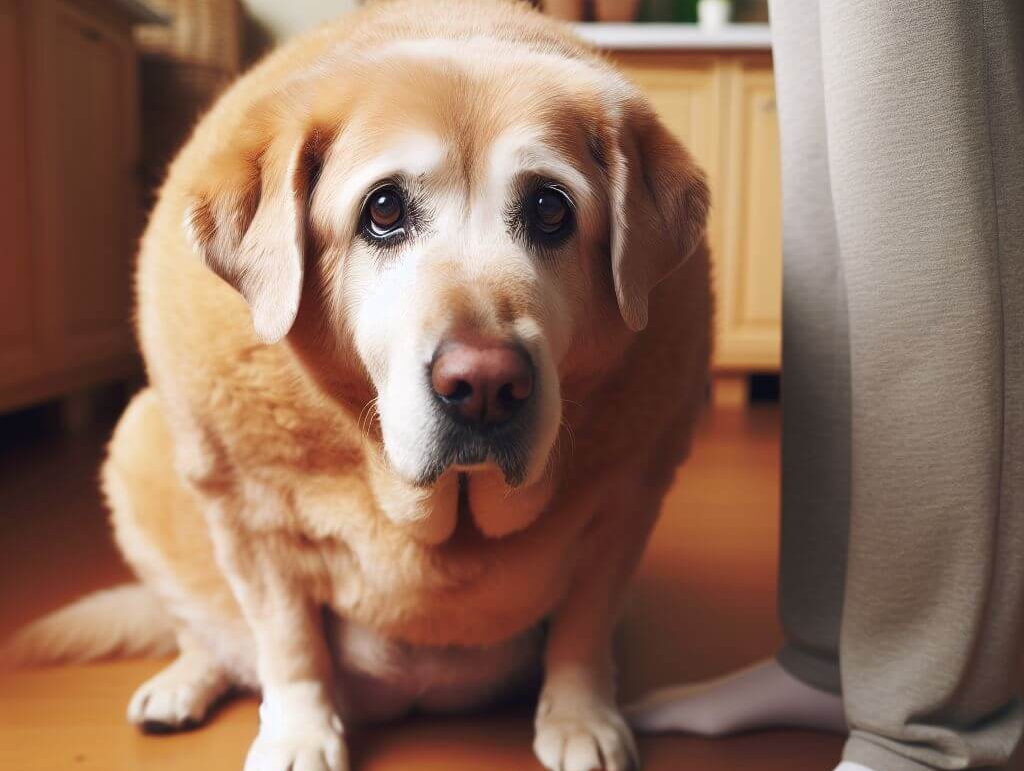Have you ever wondered if your furry companion is just a ‘cuddly’ senior, or if they might actually be tipping the scales into obesity? It’s a crucial distinction, because just like in humans, carrying extra weight can lead to a host of health issues for dogs.
Obesity in senior dogs is basically excess body fat that can significantly impact their quality of life and overall health. As dogs get older, their metabolism slows down, making them more susceptible to weight gain. This is compounded by natural decreases in activity levels due to joint pain or other age-related conditions.
Why should you care about your senior dog’s waistline? Well, it’s not just about fitting into a harness or looking svelte – it’s also about longevity and quality of life. Obesity can lead to diabetes, cardiovascular disease, and exacerbate issues like arthritis, which is especially troubling for older dogs.
The key to preventing obesity in senior dogs is early recognition and intervention. It’s much easier to maintain a healthy weight than to shed those extra pounds after they’ve crept on. Identifying risk factors, like breed predisposition or existing medical conditions, is essential.
Take my Labrador, Rio, for example. Despite Labradors being prone to obesity, at 12 years old, he’s in remarkable shape. It’s not just good genetics at play; it’s because he’s active. Regular walks and almost year-round swimming have kept him lean and muscular, a testament to the power of a consistent exercise routine.

Key Strategies for Maintaining a Healthy Weight in Aging Canines
You’re going to find out about practical ways to help your senior dog stay trim and healthy. I’m talking about balancing their diet and ensuring they get regular, age-appropriate exercise.
Choose something that resonates with you and your dog when it comes to diet. A lower-calorie diet might be necessary now that they’re older and potentially less active. Just don’t focus too much on portion size without considering the quality of the food itself. High-quality, nutrient-dense foods are essential.
In my opinion, regular exercise should never be overlooked, even for senior pets. Low-impact activities like walking or swimming can be especially beneficial for older dogs—they maintain muscle tone without putting too much strain on joints.
Lastly, I really hope that you’ll start monitoring your dog’s weight and body condition score regularly, if you aren’t already. Your vet can show you how to do this. It’s like their own personal fitness tracker, and it’s going to help you keep an eye on any weight changes that could signal a problem.
Rio’s Success Story: Lessons from an Athletic Senior Labrador
I’m going to introduce you to Rio, my own four-legged friend who’s a bit of a local celebrity. Rio, at the ripe age of 12, is a labrador — a breed that often wrestles with obesity. Yet, he’s stayed in incredibly athletic shape, and that’s no accident.
Consistent exercise is Rio’s secret sauce. It’s not just about daily walks; this dog swims more often than the ducks at the local pond. Almost every day of the year, he’s out there, whether it’s a paddle in the summer or a brave dip in cooler months. Swimming is excellent for senior dogs because it’s low impact yet incredibly effective for keeping fit.
However, maintaining an active lifestyle for a senior dog like Rio isn’t just about the right activities, it’s also about regularity and adapting to his aging body. What worked for him at 5 doesn’t necessarily apply at 12. The activities have evolved, but the dedication to them hasn’t wavered. It proves that it’s not just what you do, but how committed you are to keeping the routine.
That commitment to routine is something all pet parents can replicate. It’s been crucial for Rio’s health that I’ve kept a close eye on his ability and enthusiasm, ensuring he’s both capable and happy with the activities we choose. That’s something I want you to keep in mind as we move into our next section: the practical tips and changes you can start today to help your senior pooch stay lean and keen.

Practical Tips for Pet Parents to Combat Canine Obesity
I’m here to help you turn knowledge into action with some hands-on advice for keeping your senior dog healthy and at a comfortable weight. Remember Rio’s story? You might not have access to a year-round swimming spot, but you can still encourage regular activity tailored to your dog’s capabilities.
First things first – sit down with a calendar and carve out daily exercise times. It doesn’t have to be a marathon session; several short walks or some gentle playtime can do wonders. Choose something that resonates with you and your dog’s enjoyment.
Next, monitor what goes into your dog’s bowl. Partner with your vet to determine the best diet and portion size for your pooch. If you want to treat your dog—and let’s face it, who doesn’t?—account for those extra calories by reducing meal sizes or finding low-calorie alternatives.
Finally, commit to regular check-ins with your veterinarian. They’ll help you track your dog’s progress and adjust the plan as necessary. Just don’t focus too much on perfection; it’s the consistent effort that counts. I really hope that these tips help you to maintain your senior dog’s waistline and boost their overall health. Your four-legged friend depends on you, and with the right approach, their golden years can be vibrant and active.
Warmest Wags,
Morena
Founder, GoldenYearsPaws.com

